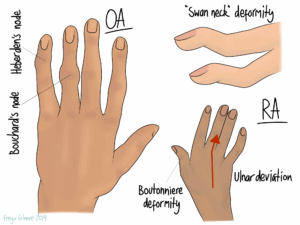What’s the Difference Between Osteoarthritis and Rheumatoid Arthritis?
Intro:
As an osteopath, I often see people who are dealing with joint pain and stiffness. Two of the most common conditions I come across are osteoarthritis and rheumatoid arthritis. They can feel quite similar at times, but they’re actually very different in how they start, how they affect your body, and how they are managed.
If you’ve ever wondered which type you or a loved one might have—or just want to understand the difference—this post is for you.
1. What is Osteoarthritis?
Let’s start with osteoarthritis, often shortened to OA. This is the most common form of arthritis. and it is estimated that 10 million people in the UK have OA. Most people think of OA when they hear the word “arthritis”.
- It’s a wear-and-tear condition.
Over time, the cartilage (the smooth surface at the ends of your bones) starts to break down. That leads to pain, stiffness, and sometimes swelling in the joints. - It’s more common as we age.
OA often affects people over 45, but it can happen earlier—especially after injury or heavy use of a joint over many years. It can even occur secondary to conditions like rheumatoid arthritis, where repeated inflammation and compensatory movement patterns affect the joints over time. - It tends to affect specific joints.
Hips, knees, hands, and the spine are the most commonly seen. It can be either in one joint, or often multiple- it isn’t always symmetrical.
2. What is Rheumatoid Arthritis?
Rheumatoid arthritis (RA) is less common, and quite different from OA.
- It’s an autoimmune condition.
This means the body’s immune system mistakenly attacks its own joints (specifically a specialised form of connecti  ve tissue called the synovium), leading to inflammation. RA also tends to have periods of flare, and relative calm.
ve tissue called the synovium), leading to inflammation. RA also tends to have periods of flare, and relative calm.
- It can start at any age.
Even young adults and children can be affected. - It’s usually symmetrical.
If it affects your right wrist, chances are your left wrist will be sore too.
- It causes more than just wear and tear.
RA can affect more than just your joints, so you may find that you have other related symptoms during a flare like fatigue, fever and malaise (general feeling of being unwell). Long-term you may also see changes to the joint shape, which is quite distinctly different to what you would see in OA.
3. How Do They Feel Different?
You might be wondering: how would I know which one I have?
- OA pain often gets worse with use and feels better with rest. Joints might feel stiff first thing in the morning, but it usually eases after 30 minutes.
- RA pain can be more constant, especially in the morning. Stiffness can last more than an hour, and joints may feel warm, swollen, and tender.
4. Can an Osteopath Help?
Yes, absolutely—but in different ways depending on the type.
- With osteoarthritis, osteopathic treatment can help improve joint mobility, reduce stiffness, and ease the surrounding muscle tension. Advice on gentle movement, posture, and home exercises can also make a big difference.
- With rheumatoid arthritis, especially during flare-ups, it’s important to work alongside your GP or rheumatologist. As osteopaths, we can support your body through the quieter phases—helping to keep you mobile and comfortable, without aggravating sensitive joints. Like with OA, we will talk about gentle movement, posture and home exercises, while being sympathetic to your needs.
Final Thoughts
Whether it’s OA or RA, living with joint pain can be difficult, and affect your life in many ways. But understanding the type of arthritis you’re dealing with is a key first step to managing it well.
Everyone is different, and has different needs and expectations. Having arthritis doesn’t necessarily have to stop what we want or need to do.
If you’re unsure which kind of arthritis you have—or just want to feel a bit more comfortable in your body—feel free to get in touch. I’m always happy to talk things through and see how I can help.
If you would like to read some more, here are some useful links and resources:
National Rheumatoid Arthritis Society
